Spatio-Temporal Changes of Urban Forests and Planning Evolution in a Highly Dynamical Urban Area: The Case Study of Wrocław, Poland
Abstract
1. Introduction
2. Materials and Methods
2.1. Study Area
2.2. Spatial Data and Methods
3. Results
3.1. Forests in the Context of Land Cover Changes (1944–2017)
3.2. Forests in the City’s Planning System (1924–2018)
4. Discussion
4.1. Forest Dynamics and Structure
4.2. Forests in the Planning System
5. Conclusions
- In-depth interdisciplinary research on informal woodlands, followed by integration of the collected data into local spatial information systems.
- Partnership and cooperation of all stakeholders (owners, managers, users) to enable the integration of informal woodland development plans into strategic and planning documents.
- Drafting of a long-term forest development plan, drawing on expert knowledge and taking into account the preferences and needs of all interested parties.
Supplementary Materials
Author Contributions
Funding
Acknowledgments
Conflicts of Interest
References
- Grimm, N.B.; Stanley, H.F.; Golubiewski, N.E.; Redman, C.L.; Wu, J.; Bai, X.; Briggs, J.M. Global Change and the Ecology of Cities. Science 2008, 319, 756–760. [Google Scholar] [CrossRef]
- Wu, J. Making the Case for Landscape Ecology. An Effective Approach to Urban Sustainability. Landsc. J. 2008, 27, 41–50. [Google Scholar] [CrossRef]
- United Nations. World Urbanization Prospects 2018. Available online: https://population.un:wup/ (accessed on 20 October 2019).
- Krajter Ostoić, S.; Salbitano, F.; Borelli, S.; Verlič, A. Urban forest research in the Mediterranean: A systematic review. Urban For. Urban Green. 2018, 31, 185–196. [Google Scholar] [CrossRef]
- Sanesi, G.; Colangelo, G.; Lafortezza, R.; Calvo, E.; Davies, C. Urban green infrastructure and urban forests: A case study of the Metropolitan Area of Milan. Landsc. Res. 2017, 42, 164–175. [Google Scholar] [CrossRef]
- Madureira, H.; Andresen, T.; Monteiro, A. Green structure and planning evolution in Porto. Urban For. Urban Green. 2011, 10, 141–149. [Google Scholar] [CrossRef]
- Referowska-Chodak, E. Pressures and Threats to Nature Related to Human Activities in European Urban and Suburban Forests. Forests 2019, 10, 765. [Google Scholar] [CrossRef]
- Szulczewska, B.; Giedych, R.; Borowski, J.; Kuchcik, M.; Sikorski, P.; Mazurkiewicz, A.; Stańczyk, T. How much green is needed for a vital neighbourhood? In search for empirical evidence. Land Use Policy 2014, 38, 330–345. [Google Scholar] [CrossRef]
- Salbitano, F.; Borelli, S.; Conigliaro, M.; Chen, Y. Guidelines on Urban and Peri-Urban Forestry; FAO Forestry Paper; Food and Agriculture Organization of the United Nations: Rome, Italy, 2016; p. 178. Available online: http://www.fao:3/a-i6210e.pdf (accessed on 20 October 2019).
- Sitzia, T.; Campagnaro, T.; Weir, R.G. Novel woodland patches in a small historical Mediterranean city: Padova, Northern Italy. Urban Ecosyst. 2016, 19, 475–487. [Google Scholar] [CrossRef]
- Konijnendijk, C.C. A decade of urban forestry in Europe. For. Policy Econ. 2003, 5, 173–186. [Google Scholar] [CrossRef]
- Cui, N.; Feng, C.C.; Wang, D.; Li, J.; Guo, L. The Effects of Rapid Urbanization on Forest Landscape Connectivity in Zhuhai City, China. Sustainability 2018, 10, 3381. [Google Scholar] [CrossRef]
- McPherson, G.; Simpson, J.R.; Peper, P.J.; Maco, S.E.; Xiao, Q. Municipal forest benefits and costs in five US cities. J. For. 2005, 103, 411–416. [Google Scholar] [CrossRef]
- Chang, C.R.; Li, M.H.; Chang, S.D. A preliminary study on the local cool-island intensity of Taipei city parks. Landsc. Urban Plan. 2007, 80, 386–395. [Google Scholar] [CrossRef]
- Escobedo, F.J.; Nowak, D.J. Spatial heterogeneity and air pollution removal by an urban forest. Landsc. Urban Plan. 2009, 90, 102–110. [Google Scholar] [CrossRef]
- Forest Research. Benefits of Green Infrastructure. Report by Forest Research, Farnham 2010. Available online: https://www.forestresearch.gov.uk/tools-and-resources/urban-regeneration-and-greenspace-partnership/greenspace-in-practice/what-is-greenspacegreen-infrastructure-gi/ (accessed on 9 September 2019).
- Gómez-Baggethun, E.; Barton, D.N. Classifying and valuing ecosystem services for urban planning. Ecol. Econ. 2013, 86, 235–245. [Google Scholar] [CrossRef]
- Wu, J. Urban ecology and sustainability: The state-of-the-science and future directions. Landsc. Urban Plan. 2014, 125, 209–221. [Google Scholar] [CrossRef]
- Kowarik, I. Wild urban woodlands: Towards a conceptual framework. In Wild Urban Woodlands: New Perspectives for Urban Forestry; Kowarik, I., Körner, S., Eds.; Springer: Berlin/Heidelberg, Germany, 2005; pp. 1–32. [Google Scholar] [CrossRef]
- Livesley, S.J.; McPherson, E.G.; Calfapietra, C. The Urban Forest and Ecosystem Services: Impacts on Urban Water, Heat, and Pollution Cycles at the Tree, Street, and City Scale. Journal of Environmental Quality. Special Section. Urban For. Ecosyst. Serv. 2016, 45, 119–124. [Google Scholar] [CrossRef]
- Forestry Commission. Bold Colliery Community Woodland: District Valuer’s Report on Property Values; Forestry Commission: Bristol, UK, 2005. [Google Scholar]
- Jim, C.Y.; Chen, W. Recreation-Amenity Use and Contingent Valuation of Urban Green Spaces in Guangzhou, China. Landsc. Urban Plan. 2006, 75, 81–96. [Google Scholar] [CrossRef]
- Hong, S.K.; Kim, J.M.; Jo, H.K.; Lee, S.W. Monetary Valuation of Urban Forest Attributes in Highly Developed Urban Environments: An Experimental Study Using a Conjoint Choice Model. Sustainability 2018, 10, 2461. [Google Scholar] [CrossRef]
- Kim, D.H.; Ahn, B.I.; Kim, E.G. Metropolitan Residents’ Preferences and Willingness to Pay for a Life Zone Forest for Mitigating Heat Island Effects during Summer Season in Korea. Sustainability 2016, 8, 1155. [Google Scholar] [CrossRef]
- O’Brien, L.; De Vreese, R.; Kern, M.; Sievänend, T.; Stojanova, B.; Atmis, E. Cultural ecosystem benefits of urban and peri-urban green infrastructure across different European countries. Urban For. Urban Green. 2017, 24, 236–248. [Google Scholar] [CrossRef]
- Konijnendijk, C.C. The Forest and the City. The Cultural Landscape of Urban Woodland; Springer International Publishing AG: Cham, Switzerland, 2018. [Google Scholar] [CrossRef]
- Millennium Ecosystem Assessment. Ecosystems and Wellbeing. Synthesis 2005. Available online: https://www.millenniumassessment:documents/document.356.aspx.pdf (accessed on 8 May 2019).
- Kaplan, S. The urban forest as a source of psychological well-being. In Urban Forest Landscapes: Integrating Multidisciplinary Perspectives; Bradley, G.A., Ed.; University of Washington Press: Seattle, WA, USA, 1995; pp. 101–108. [Google Scholar]
- Miller, R.W. Urban Forestry: Planning and Managing Urban Green Spaces, 2nd ed.; Prentice Hall: Upper Saddle River, NJ, USA, 1997. [Google Scholar]
- Konijnendijk, C.C. Between fascination and fear—The impacts of urban wilder-ness on human health and wellbeing. Soc. Tidskr. 2012, 89, 289–295. [Google Scholar]
- Ward Thompson, C.; Roe, J.; Aspinall, P. Woodland improvements in deprived urban communities: What impact do they have on people’s activities and quality of life? Landsc. Urban Plan. 2013, 118, 79–89. [Google Scholar] [CrossRef]
- Konijnendijk, C.C.; Ricard, R.M.; Kenney, A.; Randrup, T.B. Defining urban forestry—A comparative perspective of North America and Europe. Urban For. Urban Green. 2006, 4, 93–103. [Google Scholar] [CrossRef]
- Schneider, E. Der Waldpark. Ideen und Erscheinungsformen in Deutschland Zwieschen 1880–1935; Verlag Kessel: Remagen-Oberwinter, Germany, 2011. [Google Scholar]
- Turok, I.; Mykhnenko, V. The trajectories of European Cities, 1960–2005. Cities 2007, 24, 165–182. [Google Scholar] [CrossRef]
- Großmann, K.; Haase, A.; Rink, D.; Steinführer, A. Urban Shrinkage in East Central Europe? Benefits and Limits of a Cross-National Transfer of Research Approaches. In Declining Cities Developing Cities: Polish and German Perspectives; Nowak, M., Nowosielski, M., Eds.; Instytut Zachodni: Poznań, Poland, 2008; pp. 77–99. [Google Scholar]
- Kabisch, N.; Haase, D. Diversifying European agglomerations: Evidence of urban population trends for the 21st century. Popul. Space Place 2011, 253, 236–253. [Google Scholar] [CrossRef]
- Rink, D.; Couch, C.; Haase, A.; Krzysztofik, R.; Nadolu, B.; Rumpel, P. The governance of urban shrinkage in cities of post-socialist Europe: Policies, strategies and actors. Urban Res. Pract. 2014, 7, 258–277. [Google Scholar] [CrossRef]
- Kroll, F.; Haase, D. Does demographic change affect land use patterns? A case study from Germany. Land Use Policy 2010, 27, 726–737. [Google Scholar] [CrossRef]
- Fuller, R.A.; Gaston, K.J. The scaling of green space coverage in European cities. Biol. Lett. 2009, 5, 352–355. [Google Scholar] [CrossRef]
- Kabisch, N.; Strohbach, M.; Haase, D.; Kronenberg, J. Urban green space availability in European cities. Ecol. Indic. 2016, 70, 586–596. [Google Scholar] [CrossRef]
- Kabisch, N.; Haase, D. Green spaces of European cities revisited for 1990–2006. Landsc. Urban Plan. 2013, 110, 113–122. [Google Scholar] [CrossRef]
- Salvati, L.; Ranalli, F.; Carlucci, M.; Ippolito, A.; Ferrara, A.; Corona, P. Forest and the city: A multivariate analysis of peri-urban forest landcover patterns in 283 European metropolitan areas. Ecol. Indic. 2017, 73, 369–377. [Google Scholar] [CrossRef]
- Stanilov, K.; Sýkora, L. (Eds.) Confronting Suburbanization: Urban Decentralization in Postsocialist Central and Eastern Europe; Wiley Bleckwell: Chichester, UK, 2014. [Google Scholar]
- Kronenberg, J. Why not to green a city? Institutional barriers to preserving urban ecosystem services. Ecosyst. Serv. 2015, 12, 218–227. [Google Scholar] [CrossRef]
- Krajter Ostoić, S.; Konijnendijk van den Bosch, C.C.; Vuletić, D.; Stevanov, M.; Živojinović, I.; Mutabdžija-Bećirović, S.; Lasarević, J.; Stojanova, B.; Blagojević, D.; Stojanovska, M.; et al. Citizens’ perception of and satisfaction with urban forests and green space: Results from selected Southeast European cities. Urban For. Urban Green. 2017, 23, 93–103. [Google Scholar] [CrossRef]
- Mantey, D.; Sudra, P. Types of suburbs in post-socialist Poland and their potential for creating public spaces. Cities 2019, 88, 209–221. [Google Scholar] [CrossRef]
- Sýkora, L. Changes in the internal spatial structure of post-communist Prague. GeoJournal 1999, 49, 79–89. [Google Scholar] [CrossRef]
- Steinführer, A.; Haase, A. Demographic Change as a Future Challenge for Cities in East Central Europe. Geogr. Ann. 2007, 89, 183–195. [Google Scholar] [CrossRef]
- Kotus, J. Changes in the spatial structure of a large Polish city—The case of Poznan. Cities 2006, 23, 364–381. [Google Scholar] [CrossRef]
- Kok, H. Migration from the city to the countryside in Hungary and Poland. GeoJournal 1999, 49, 53–62. [Google Scholar] [CrossRef]
- Leetmaa, K.; Tammaru, T. Suburbanization in countries in transition: Destinations of suburbanizers in the Tallinn metropolitan area. Geogr. Ann. 2007, 89, 127–146. [Google Scholar] [CrossRef]
- Jaszczak, R. Forests and forest economy within the range of impact by towns and cities in Poland. In: Studia i Materiały Centrum Edukacji Przyrodniczo-Leśnej. Annal 2008, 10, 152–171. Available online: http://cepl.sggw.pl/sim/pdf/sim19_pdf/15_Jaszczak.pdf (accessed on 21 April 2019).
- Polna, M. Changes in Poland’s tree cover in the years 1990–2001. Acta Sci. Pol. Silvarum Colendarum Ratio Ind. Lignaria 2005, 4, 51–60. Available online: http://www.forestry.actapol.net/tom4/zeszyt1/streszczenie-5.html (accessed on 22 April 2019).
- Szymańska, D.; Lewandowska, A.; Rogatka, K. Temporal trend of green areas in Poland between 2004 and 2012. Urban For. Urban Green. 2015, 14, 1009–1016. [Google Scholar] [CrossRef]
- Feltynowski, M.; Kronenberg, J.; Bergier, T.; Kabisch, N.; Łaszkiewicz, E.; Strohbach, M.W. Challenges of urban green space management in the face of using inadequate data. Urban For. Urban Green. 2018, 31, 56–66. [Google Scholar] [CrossRef]
- Ode, Å.; Fry, G. A model for quantifying and predicting urban pressure on woodland. Landsc. Urban Plan. 2006, 77, 17–27. [Google Scholar] [CrossRef]
- Jorgensen, A.; Tylecote, M. Ambivalent Landscapes—Wilderness in the Urban Interstices. Landsc. Res. 2007, 32, 443–462. [Google Scholar] [CrossRef]
- Rupprecht, C.D.D.; Byrne, J. Informal urban greenspace: A typology and trilingual systematic review of its role for urban residents and trends in the literature. Urban For. Urban Green. 2014, 13, 597–611. [Google Scholar] [CrossRef]
- Kim, G. Assessing Urban Forest Structure, Ecosystem Services, and Economic Benefits on Vacant Land. Sustainability 2016, 8, 679. [Google Scholar] [CrossRef]
- Kowarik, I.; Körner, S. Wild Urban Woodlands. New Perspectives for Urban Forestry; Springer: Berlin/Heidelberg, Germany, 2005. [Google Scholar]
- Dettmar, J. Forests for Shrinking Cities? The Project “Industrial Forests of the Ruhr”. In Wild Urban Woodlands: New Perspectives for Urban Forestry; Kowarik, I., Körner, S., Eds.; Springer: Berlin/Heidelberg, Germany, 2005; pp. 263–276. [Google Scholar] [CrossRef]
- Rink, D.; Emmrich, R. Surrogate nature or wilderness? Social perceptions and notions of nature in an urban context. In Wild Urban Woodlands: New Perspectives for Urban Forestry; Kowarik, I., Körner, S., Eds.; Springer: Berlin/Heidelberg, Germany, 2005; pp. 67–80. [Google Scholar] [CrossRef]
- Haase, D. Urban ecology of shrinking cities: An unrecognized opportunity? Nat. Cult. 2008, 3, 1–8. [Google Scholar] [CrossRef]
- Rink, D. Wilderness: The Nature of Urban Shrinkage? The Debate on Urban Restructuring and Restoration in Eastern Germany Dieter Rink. Nat. Cult. 2009, 4, 275–292. [Google Scholar] [CrossRef]
- Salvati, L.; Biasi, R.; Carlucci, M.; Ferrara, A. Forest transition and urban growth: Exploring latent dynamics (1936–2006) in Rome, Italy, using a geographically weighted regression and implications for coastal forest conservation. Rend. Lincei 2015, 26, 577–585. [Google Scholar] [CrossRef]
- Grigorescu, I.; Geacu, S. The dynamics and conservation of forest ecosystems in Bucharest Metropolitan Area. Urban For. Urban Green. 2017, 27, 90–99. [Google Scholar] [CrossRef]
- Li, Y.; Xue, C.; Shao, H.; Shi, G.; Jiang, N. Study of the Spatiotemporal Variation Characteristics of Forest Landscape Patterns in Shanghai from 2004 to 2014 Based on Multisource Remote Sensing Data. Sustainability 2018, 10, 4397. [Google Scholar] [CrossRef]
- GUS—Główny Urząd Statystyczny (Central Statistical Office); GUS: Warsaw, Poland, 2018.
- GUS—Główny Urząd Statystyczny (Central Statistical Office); GUS: Warsaw, Poland, 2015.
- Kondracki, J. Poland’s Physical Geography; PWN: Warsaw, Poland, 1988. [Google Scholar]
- Dubicki, A.; Dubicka, M.; Szymanowski, M. Wrocław’s climate. In Information Guide on Wrocław’s Environment 2002; Smolnicki, K., Szykasiuk, M., Eds.; Dolnośląska Fundacja Ekorozwoju: Wrocław, Poland, 2002; pp. 9–25. [Google Scholar]
- Walczak, W. The Pre-Sudeten Area; Państwowe Wydawnictwo Naukowe: Warsaw, Poland, 1970. [Google Scholar]
- Guziak, A. Biosfera [Biosphere]. In Information Guide on Wrocław’s Environment 2002; Smolnicki, K., Szykasiuk, M., Eds.; Dolnośląska Fundacja Ekorozwoju: Wrocław, Poland, 2002; pp. 74–98. [Google Scholar]
- Poviat Wrocław Tree Cover Increase Programme. In Proceedings of the Appendix to Resolution No. LII/3183/06 of the Wrocław City Council, Wrocław, Poland, 8 June 2006.
- Bender, O.; Hans Boehmer, J.; Jens, D.; Schumacherd, K. Using GIS to analyse long-term cultural landscape change in Southern Germany. Landsc. Urban Plan. 2005, 70, 111–125. [Google Scholar] [CrossRef]
- Schneeberger, N. Transformation Rates and Driving Forces of Landscape Change on the Northern Fringe of the Swiss Alps. Ph.D. Thesis, ETH Zurich Research Collection, Zurich, Switzerland, 2005. [Google Scholar]
- Käyhkö, N.; Skånes, H. Change trajectories and key biotopes—Assessing landscape dynamics and sustainability. Landsc. Urban Plan. 2006, 75, 300–321. [Google Scholar] [CrossRef]
- Käyhkö, N.; Skånes, H. Retrospective land cover/land use change trajectories as drivers behind the local distribution and abundance patterns of oaks in south-western Finland. Landsc. Urban Plan. 2008, 88, 12–22. [Google Scholar] [CrossRef]
- Antrop, M.; Van Eetvelde, V. Landscape Perspectives. The Holistic Nature of Landscape. In Landscape; Chen, J., Silbernagel, J., Eds.; Series 23; Springer: Dordrecht, The Netherlands, 2017. [Google Scholar]
- Forest Act. The Act on Forest of 28 September 1991. Dz.U. 1991, nr 101 poz. 444. Available online: http://prawo.sejm.gov.pl/isap.nsf/DocDetails.xsp?id=WDU19911010444 (accessed on 8 May 2019).
- McGarigal, K.; Marks, B.J. FRAGSTATS: Spatial Pattern Analysis Program for Quantifying Landscape Structure. Gen. Tech. Rep. PNW, Department of Agriculture; Forest Service, Pacific Northwest Research Station: Portland, OR, USA, 1994. [Google Scholar] [CrossRef]
- McGarigal, K.; Cushman, S.A.; Ene, E. FRAGSTATS v4: Spatial Pattern Analysis Program for Categorical and Continuous Maps. Computer Software Program Produced by the Authors at the University of Massachusetts, Amherst 2012. Available online: http://www.umass.edu/landeco/research/fragstats/fragstats.html (accessed on 8 May 2019).
- Agnoletti, M. The development of a historical and cultural evaluation approach in landscape assessment: The dynamic of Tuscan Landscape between 1832 and 2004. In The Conservation of Cultural Landscapes; Agnoletti, M., Ed.; University of Florence: Florence, Italy, 2006; pp. 3–30. [Google Scholar]
- Solon, J. Spatial context of urbanization: Landscape pattern and changes between 1950 and 1990 in the Warsaw metropolitan area, Poland. Landsc. Urban Plan. 2009, 93, 250–261. [Google Scholar] [CrossRef]
- Simoniello, T.; Coluzzi, R.; Imbrenda, V.; Lanfredi, M. Land cover changes and forest landscape evolution (1985–2009) in a typical Mediterranean agroforestry system (high Agri Valley). Nat. Hazards Earth Syst. Sci. 2015, 15, 1201–1214. [Google Scholar] [CrossRef]
- Rubiano, K.; Clerici, N.; Norden, N.; Etter, A. Secondary Forest and Shrubland Dynamics in a Highly Transformed Landscape in the Northern Andes of Colombia (1985–2015). Forests 2017, 8, 216. [Google Scholar] [CrossRef]
- Wrocław Development Office and Wrocław University of Science and Technology. Study on the Conditions and Directions of Land Development in Wrocław; Wrocław Development Office and Wrocław University of Science and Technology: Wrocław, Poland, 1998. [Google Scholar]
- Biuro Rozwoju Wrocławia. Study on the Conditions and Directions of Land Development in Wrocław; Biuro Rozwoju Wrocławia: Wrocław, Poland, 2018. [Google Scholar]
- Harańczyk, A. Przemiany w użytkowaniu gruntów w miastach wojewódzkich w latach 2010–2014 [Transformations in land use in provincial cities in the years 2010–2014]. Studia Miej. 2015, 18, 131–146. [Google Scholar]
- Feltynowski, M. Land−use plans and a change of use of forest land in the urban communes in Poland. Sylwan 2015, 159, 252–258. [Google Scholar]
- Paszkowski, Z. Trends in the development of Polish urban planning. In Poles’ Living Space; Sepioł, J., Ed.; Association of Polish Architects SARP: Warsaw, Poland, 2014; pp. 15–36. [Google Scholar]
- Kasanko, M.; Barredo, J.I.; Lavalle, C.; McCormick, N.; Demicheli, L.; Sagris, V.; Brezger, A. Are European cities becoming dispersed? A comparative analysis of 15 European urban areas. Landsc. Urban Plan. 2006, 77, 111–130. [Google Scholar] [CrossRef]
- Maruani, T.; Amit-Cohen, I. Open space planning models: A review of approaches and methods. Landsc. Urban Plan. 2007, 81, 1–13. [Google Scholar] [CrossRef]
- Sandström, U.G. Green Infrastructure Planning in Urban Sweden. Plan. Pract. Res. 2002, 17, 373–385. [Google Scholar] [CrossRef]
- Tzoulas, K.; Korpela, K.; Venn, S.; Yli-Pelkonen, V.; Kaźmierczak, A.; Niemela, J.; James, P. Promoting ecosystem and human health in urban areas using green infrastructure: A literature review. Landsc. Urban Plan. 2007, 81, 167–178. [Google Scholar] [CrossRef]
- Magistrat der Hauptstadt Breslau. Siedlung und Stadtplanung in Schlesien. Heft 1. Breslau. Stadtplanung, Wohnung und Siedlung; Magistrat der Hauptstadt Breslau: Breslau, Poland, 1926. [Google Scholar]
- Hanisch, F. Welche Bedeutung haben Stadtwaldanlagen für Industrie und Großstädte? Die Gart. 1909, 11, 183–193. [Google Scholar]
- Kononowicz, W. Issues Related to Formal Transformations in Wrocław’s Urban Planning in the 19th and the Early 20th c. Biuletyn Historii Sztuki XLI; Polish Academy of Sciences, Art Institute: Warsaw, Poland, 1979; pp. 225–229. [Google Scholar]
- Bińkowska, I. The formation of the urban green system in Wrocław in the 19th and the early 20th c. In Wrocław’s Architecture City Planning until 1945; Rozpędowski, J., Ed.; Oficyna Wydawnicza Politechniki Wrocławskiej: Wrocław, Poland, 1995; pp. 225–244. [Google Scholar]
- Kononowicz, W. Ubran Planning in the 19th and 20th c. Encyclopaedia of Wrocław; Wydawnictwo Dolnośląskie: Wrocław, Poland, 2001; p. 873. [Google Scholar]
- Przyłęcka, D. Wrocław was not rebuilt in a day. In Land Development Plans, Urban Planning and Architectural Concepts and Designs and Their Implementation in the Years 1945–1989; Oficyna Wydawnicza ATUT: Wrocław, Poland, 2012. [Google Scholar]
- Rydberg, D.; Falck, J. Urban forestry in Sweden from a silvicultural perspective: A review. Landsc. Urban Plan. 2000, 47, 1–18. [Google Scholar] [CrossRef]
- Schmidt, C.; Böttner, S. Modul Erholung. Zwischenbericht in der Wissenschaftlichen Begleitforschung zum Erprobungsund Entwicklungsvorhaben der Stadt Leipzig „Urbane Wälder” im Auftrag des Bundesamtes für Naturschutz 2016. Available online: http://urbane-waelder.de/index_htm_files/Erholung%20-%20lang.pdf (accessed on 3 October 2019).
- Keil, A. Use and Perception of Post-Industrial Urban Landscapes in the Ruhr. In Wild Urban Woodlands; Kowarik, I., Körner, S., Eds.; Springer: Berlin/Heidelberg, Germany, 2005; pp. 117–130. [Google Scholar] [CrossRef]
- Davies, C. People Working for Nature in the Urban Forest. In Wild Urban Woodlands; Kowarik, I., Körner, S., Eds.; Springer: Berlin/Heidelberg, Germany, 2005; pp. 131–142. [Google Scholar] [CrossRef]
- Rink, D.; Arndt, T. Urbane Wälder: Ökologische Stadterneuerung durch Anlage Urbaner Waldflächen auf Innerstädtischen Flächen im Nutzungswandel. Ein Beitrag zur Stadtentwicklung in Leipzig. Helmholtz-Zentrum für Umweltforschung—UFZ Department Stadt und Umweltsoziologie 2011. Leipzig. Available online: https://www.ufz.de/index.php?de=40465 (accessed on 3 October 2019).
- Bell, S.; Blom, D.; Rautamäki, M.; Castel-Branco, C.; Simson, A.; Asger Olsen, I. Design of Urban Forests. In Urban Forests and Trees; Konijnendijk, C.C., Nilsson, K., Randrup, T.B., Schipperijn, J., Eds.; Springer: Berlin/Heidelberg, Germany; New York, NY, USA, 2005; pp. 149–186. [Google Scholar] [CrossRef]
- Schmidt, C. Urbane Wälder zwischen Forst und Park. In Aktuelle Fragen der Baumpflege und–Verwendung, Stadtbaumeigenschaften und Wirkungen Tagungsband Dresdner StadtBaumtage in Tharandt am 12./13.03.2015; Technische Universität Dresden: Dresden, Germany, 2015; pp. 144–154. [Google Scholar]
- Kowarik, I.; Langer, A. Natur-Park Südgelände: Linking Conservation and Recreation in an Abandoned Rail Yard in Berlin. In Wild Urban Woodlands: New Perspectives for Urban Forestry; Kowarik, I., Körner, S., Eds.; Springer: Berlin/Heidelberg, Germany, 2005; pp. 287–299. [Google Scholar] [CrossRef]
- Jorgensen, A.; Hitchmough, J.; Dunnett, N. Living in the Urban Wildwoods: A Case Study of Birchwood, Warrington New Town, UK. In Wild Urban Woodlands: New Perspectives for Urban Forestry; Kowarik, I., Körner, S., Eds.; Springer: Berlin/Heidelberg, Germany, 2005; pp. 95–116. [Google Scholar] [CrossRef]
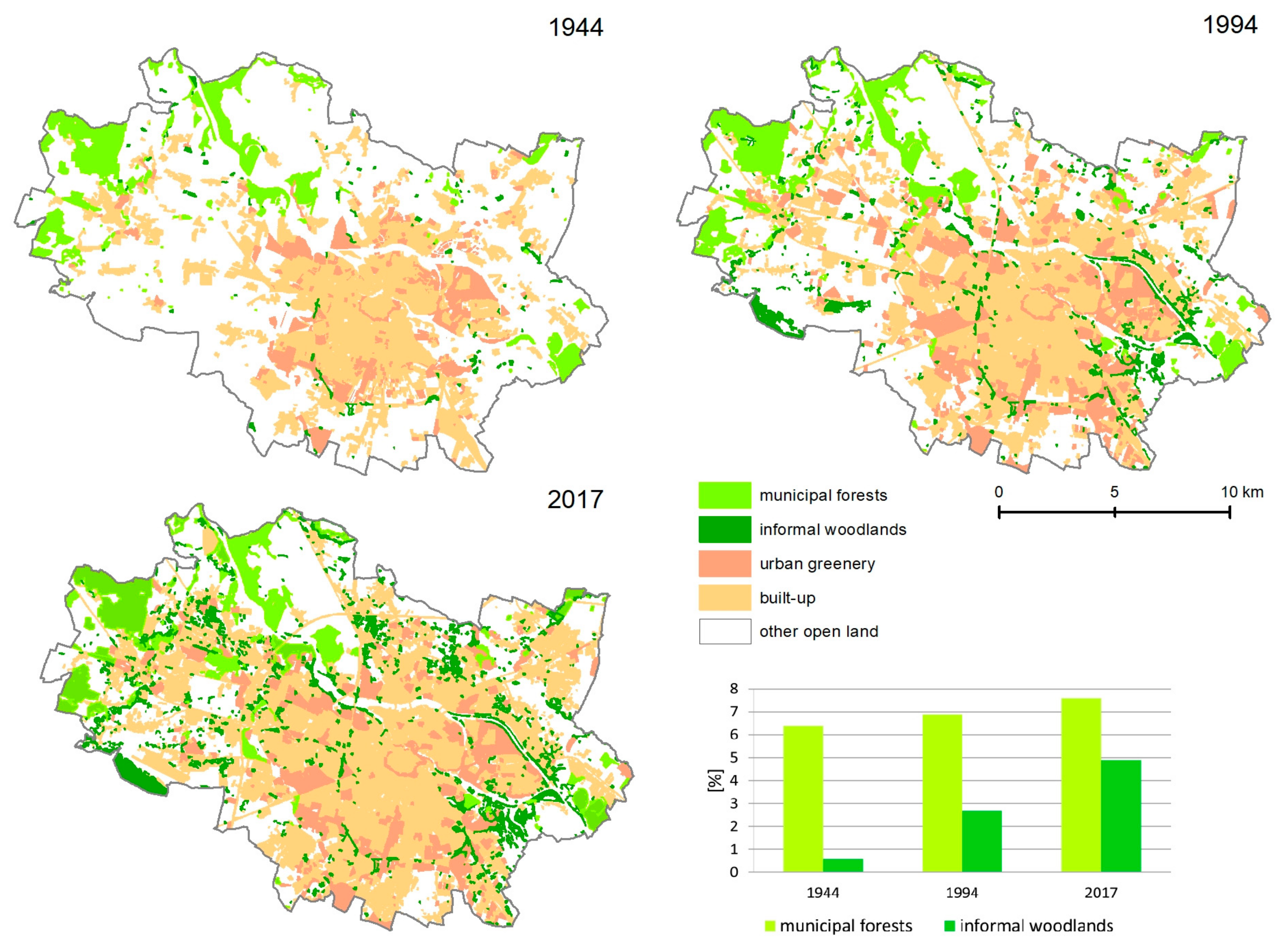
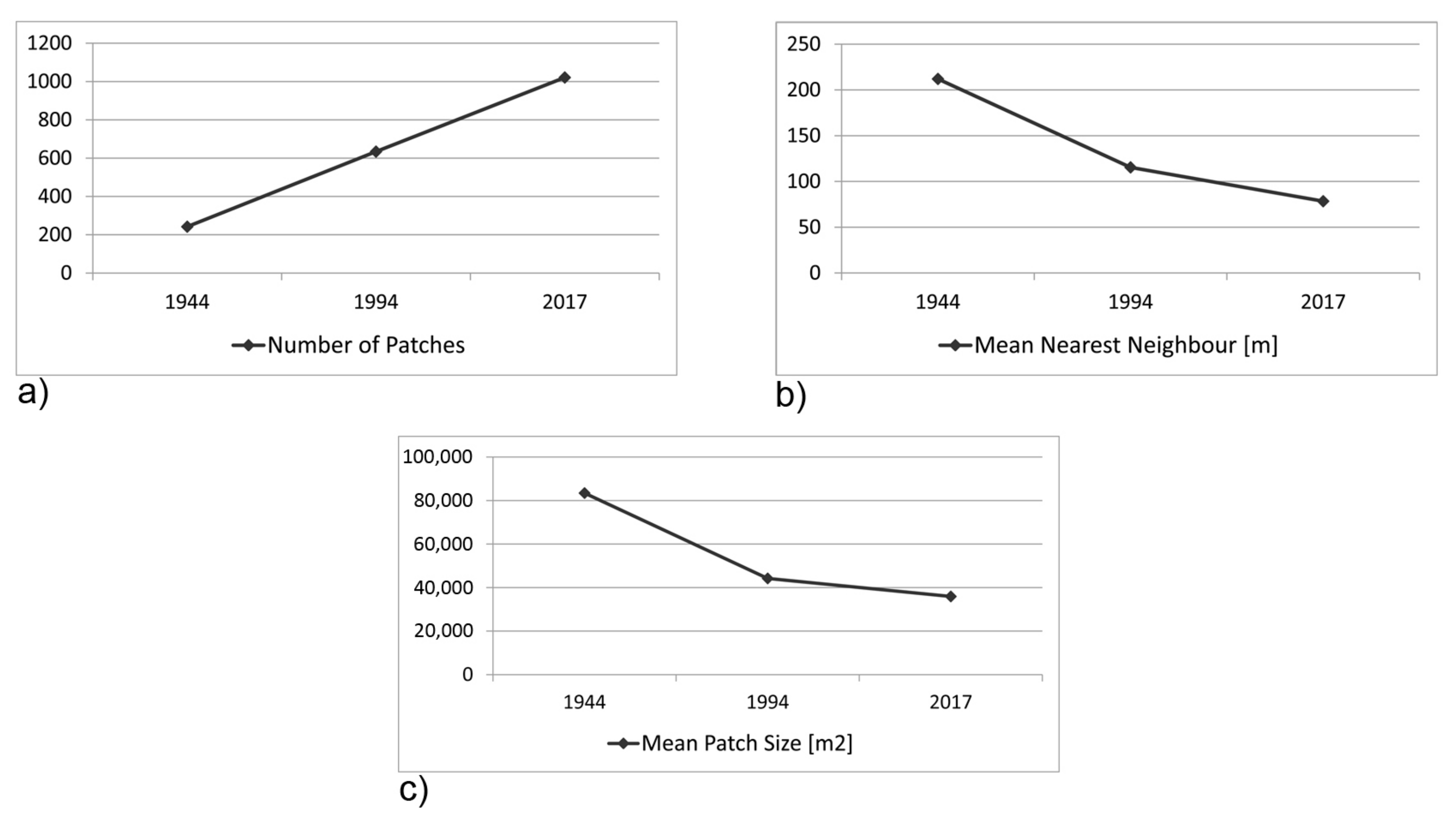
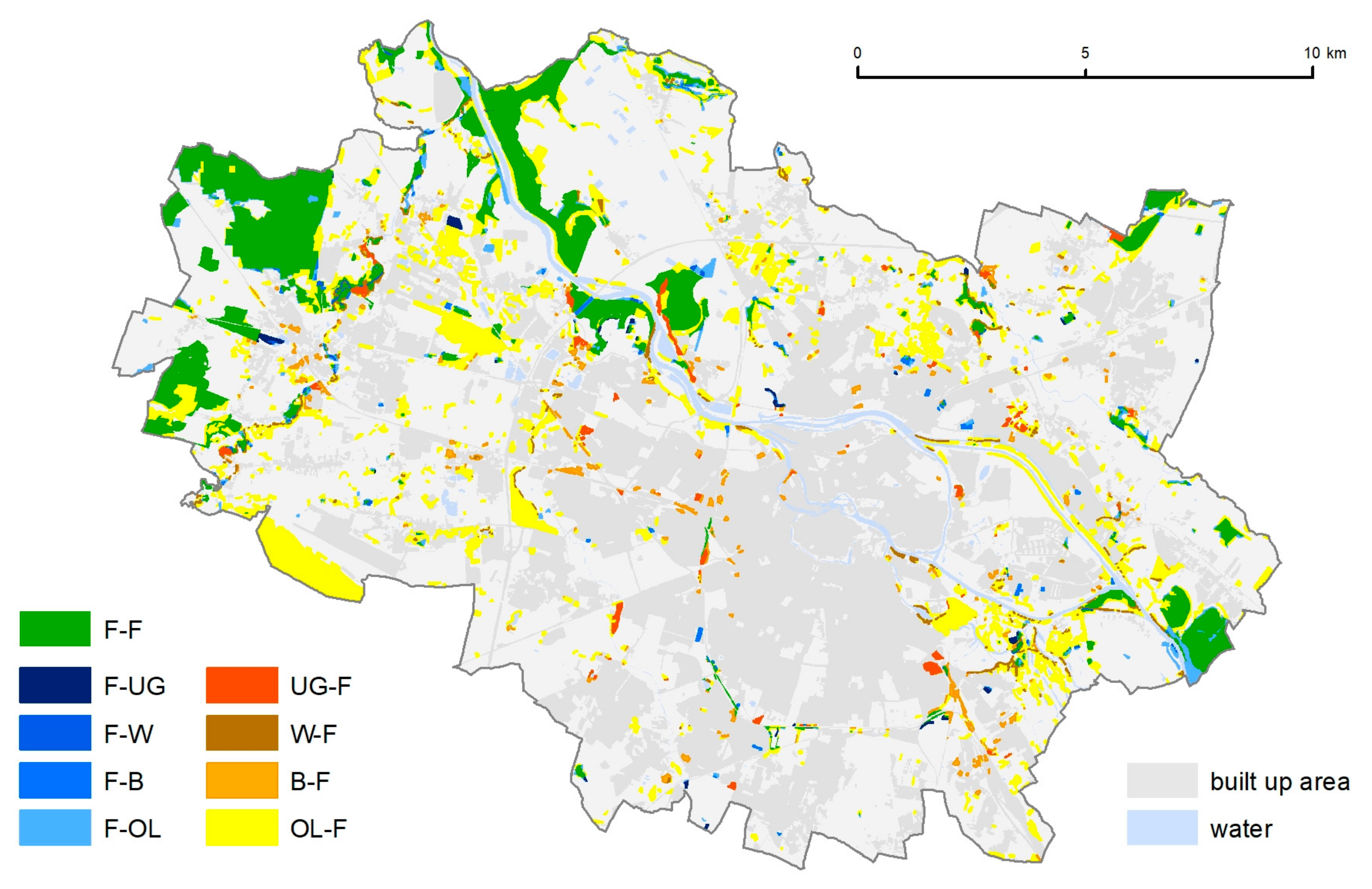

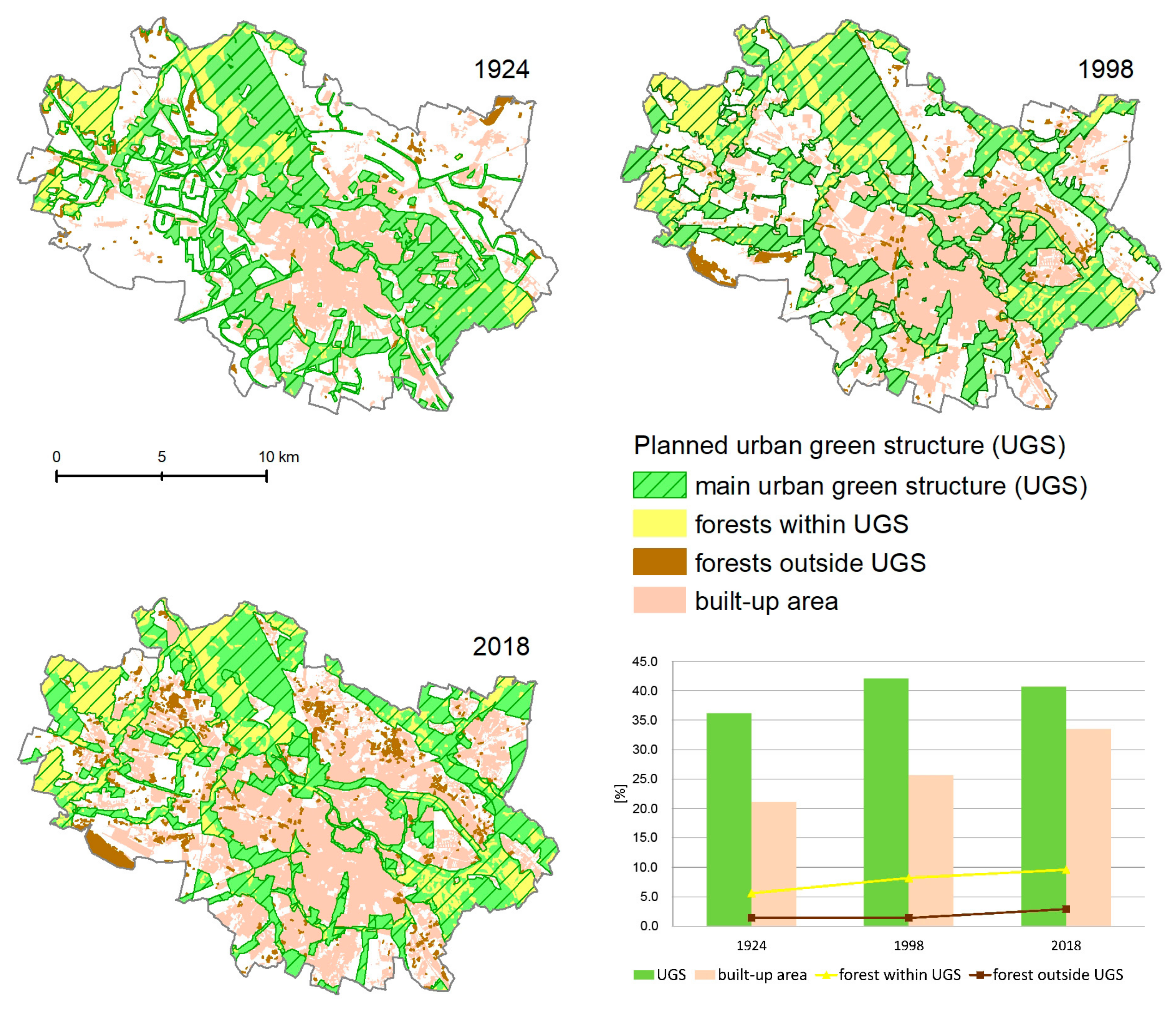
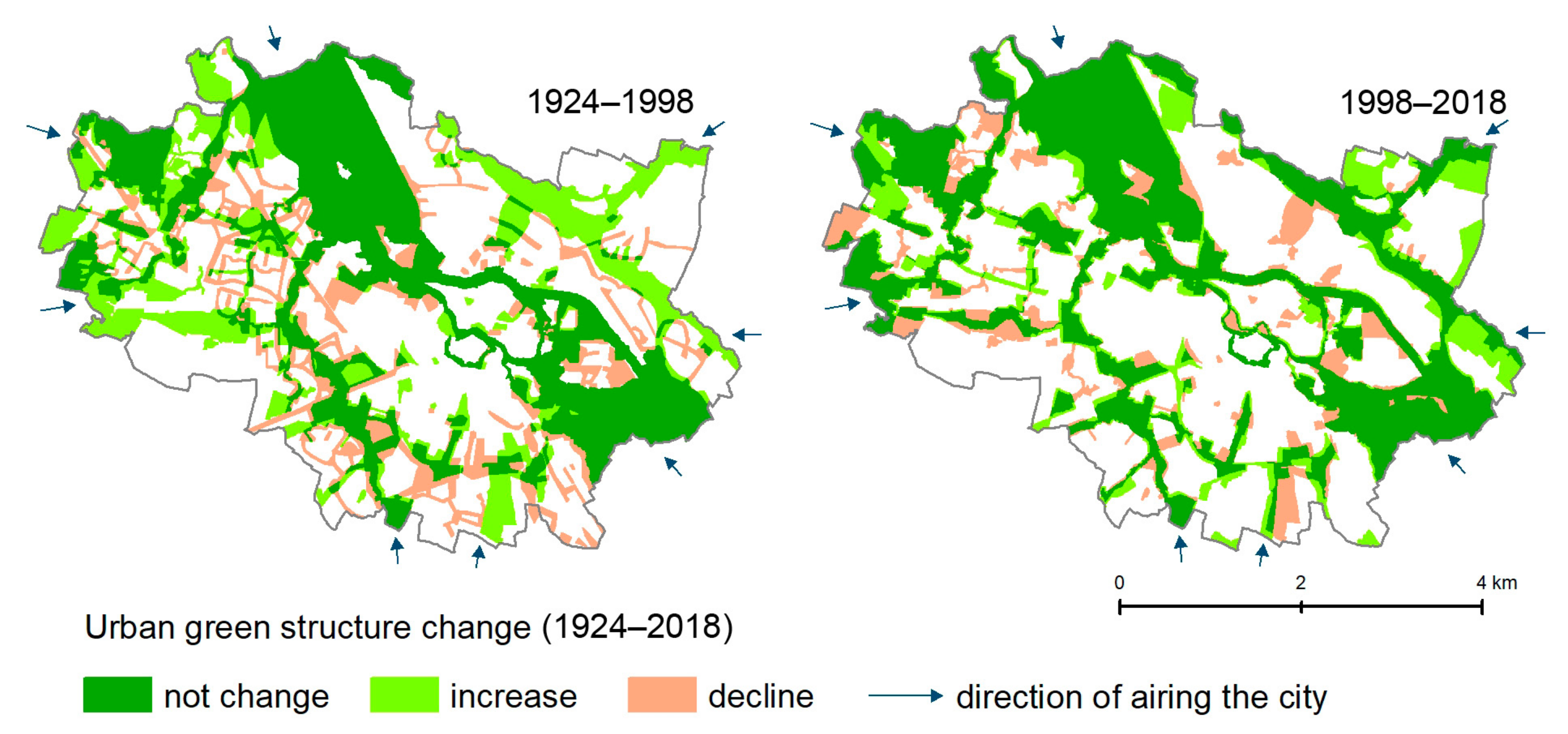
| Maps | Source | Year | Scale |
| German topographic map (Messtischblatt) | Berlin State Library | 1942 | 1:25,000 |
| Polish topographic map | Provincial Centre for Geodesic and Cartographic Documentation | 1995–1998 | 1:10,000 |
| Standard cartographic materials KARTO10K | Provincial Centre for Geodesic and Cartographic Documentation | 2015–2016 | 1:10,000 |
| Aerial photos and orthophotomaps | Source | Year | |
| Aerial photos | Herder Institut in Marburg | 1944 | |
| Orthophotomap | Head Office of Land Surveying and Cartography | 1994 | |
| Orthophotomap | Head Office of Head Office of Land Surveying and Cartography | 2015–2017 | |
| Database | Source | Year | |
| Map of green spaces | Spatial Information System (SIP) of Wrocław, Wrocław Municipality | 2018 | |
| Study on the conditions and directions of land development in Wrocław | Spatial Information System (SIP) of Wrocław, Wrocław Municipality | 1998 | |
| Study on the conditions and directions of land development in Wrocław | Spatial Information System (SIP) of Wrocław, Wrocław Municipality | 2018 | |
| Plans | Source | Year | |
| Wrocław’s first general plan, City Expansion | Association Wratislaviae Amici | 1924 |
| Land Cover Types | 1944 | 1994 | 2017 | |||
|---|---|---|---|---|---|---|
| ha | % | ha | % | ha | % | |
| Forest | 2039.9 | 7.0 | 2824.1 | 9.7 | 3667.7 | 12.5 |
| Urban greenery | 1607.4 | 5.5 | 2554.3 | 8.3 | 2489.9 | 8.5 |
| Water | 820.3 | 2.8 | 820.0 | 2.8 | 815.7 | 2.8 |
| Built-up area | 6172.1 | 21.1 | 7511.3 | 25.7 | 9786.0 | 33.5 |
| Open land | 18,614.3 | 63.6 | 15,678.1 | 53.6 | 12,494.7 | 42.7 |
| Area in 2017 | ||||||||||||
|---|---|---|---|---|---|---|---|---|---|---|---|---|
| Area in 1944 | Urban Forests | Urban Greenery | Water | Built-up Area | Open Land | Total Area (1944) | ||||||
| ha | % | ha | % | ha | % | ha | % | ha | % | ha | % | |
| Urban forests | 1813.90 | 6.2 | 20.14 | 0.1 | 12.54 | 0.04 | 24.25 | 0.1 | 169.02 | 0.6 | 2039.85 | 7.0 |
| Urban greenery | 71.96 | 0.3 | 1094.54 | 3.7 | 7.13 | 0.02 | 287.71 | 1.0 | 146.10 | 0.5 | 1607.44 | 5.5 |
| Water | 62.67 | 0.2 | 14.70 | 0.1 | 508.72 | 1.74 | 38.78 | 0.1 | 195.40 | 0.7 | 820.27 | 2.8 |
| Built-up area | 122.02 | 0.4 | 179.77 | 0.6 | 6.24 | 0.02 | 5166.03 | 17.7 | 698.07 | 2.4 | 6172.13 | 21.1 |
| Open land | 1597.13 | 5.5 | 1180.73 | 4.0 | 281.05 | 0.96 | 4269.28 | 14.6 | 11,286.1 | 38.6 | 18,614.30 | 63.6 |
| Total area (2017) | 3667.7 | 12.5 | 2489.9 | 8.5 | 815.7 | 2.8 | 9786.1 | 33.5 | 12,494.7 | 42.7 | ||
© 2019 by the authors. Licensee MDPI, Basel, Switzerland. This article is an open access article distributed under the terms and conditions of the Creative Commons Attribution (CC BY) license (http://creativecommons.org/licenses/by/4.0/).
Share and Cite
Jaworek-Jakubska, J.; Filipiak, M.; Michalski, A.; Napierała-Filipiak, A. Spatio-Temporal Changes of Urban Forests and Planning Evolution in a Highly Dynamical Urban Area: The Case Study of Wrocław, Poland. Forests 2020, 11, 17. https://doi.org/10.3390/f11010017
Jaworek-Jakubska J, Filipiak M, Michalski A, Napierała-Filipiak A. Spatio-Temporal Changes of Urban Forests and Planning Evolution in a Highly Dynamical Urban Area: The Case Study of Wrocław, Poland. Forests. 2020; 11(1):17. https://doi.org/10.3390/f11010017
Chicago/Turabian StyleJaworek-Jakubska, Justyna, Maciej Filipiak, Adam Michalski, and Anna Napierała-Filipiak. 2020. "Spatio-Temporal Changes of Urban Forests and Planning Evolution in a Highly Dynamical Urban Area: The Case Study of Wrocław, Poland" Forests 11, no. 1: 17. https://doi.org/10.3390/f11010017
APA StyleJaworek-Jakubska, J., Filipiak, M., Michalski, A., & Napierała-Filipiak, A. (2020). Spatio-Temporal Changes of Urban Forests and Planning Evolution in a Highly Dynamical Urban Area: The Case Study of Wrocław, Poland. Forests, 11(1), 17. https://doi.org/10.3390/f11010017





